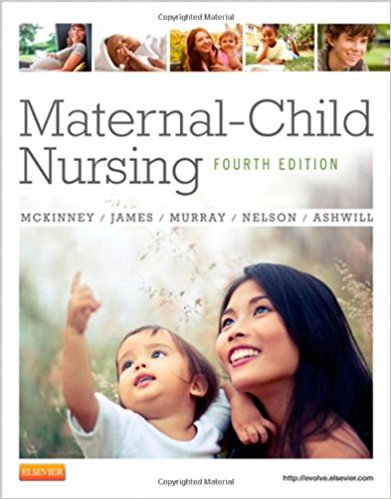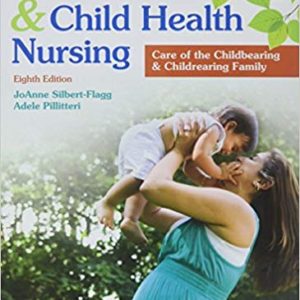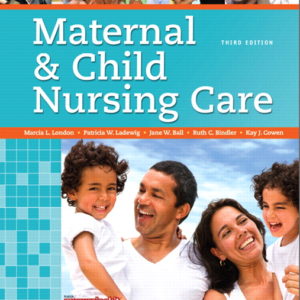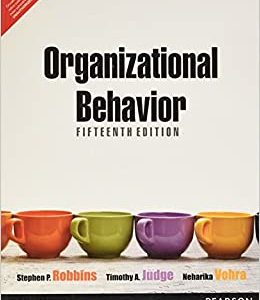Test Bank for Maternal Child Nursing 4th Edition by McKinney James Murray Nelson and Ashwill
$35
Description
Test Bank for Maternal Child Nursing 4th Edition by McKinney James Murray Nelson and Ashwill
Chapter 3: The Childbearing and Child-Rearing Family Test Bank
MULTIPLE CHOICE
- The formula used to guide time-out as a disciplinary method is
- 1 minute per each year of the child’s age
- To relate the length of the time-out to the severity of the behavior
- Never to use time-out for a child younger than 4 years
- To follow the time-out with a treat
ANS: A
| Feedback | |
| A | It is important to structure time-out in a time frame that allows the child to
understand why he or she has been removed from the environment. |
| B | Relating time to a behavior is subjective and is inappropriate when the child is
very young. |
| C | Time-out can be used with the toddler. |
| D | Negative behavior should not be reinforced with a positive action. |
PTS: 1 DIF: Cognitive Level: Knowledge REF: p. 50
OBJ: Nursing Process: Assessment MSC: Client Needs: Health Promotion and Maintenance
- The nurse observes that when an 8-year-old boy enters the playroom, he often causes disruption by taking toys from other The nurse’s best approach for this behavior is to
- Ban the child from the
- Explain to the children in the playroom that he is very ill and should be allowed to have the
- Approach the child in his room and ask, “Would you like it if the other children took your toys from you?”
- Approach the child in his room and state, “I am concerned that you are taking the other children’s toys. It upsets them and me.”
ANS: D
| Feedback | |
| A | Banning the child from the playroom will not solve the problem. The problem is
his behavior, not the place where he exhibits it. |
| B | Illness is not a reason for a child to be undisciplined. When the child recovers,
the parents will have to deal with a child who is undisciplined and unruly. |
| C | Children should not be made to feel guilty and to have their self-esteem attacked. |
| D | By the nurse’s using “I” rather than the “you” message, the child can focus on the behavior. The child and the nurse can begin to explore why the behavior
occurs. |
PTS: 1 DIF: Cognitive Level: Application REF: p. 50
OBJ: Nursing Process: Planning MSC: Client Needs: Health Promotion and Maintenance
- Families who deal effectively with stress exhibit which behavior pattern?
- Focus on family problems
- Feel weakened by stress
- Expect that some stress is normal
- Feel guilty when stress exists
ANS: C
| Feedback | |
| A | Healthy families focus on family strengths rather than on the problems and know
that stress is temporary and may be positive. |
| B | If families are dealing effectively with stress, then weakening of the family unit
should not occur. |
| C | Healthy families recognize that some stress is normal in all families. |
| D | Because some stress is normal in all families, feeling guilty is not reasonable.
Guilt only immobilizes the family and does not lead to resolution of the stress. |
PTS: 1 DIF: Cognitive Level: Comprehension REF: p. 42
OBJ: Nursing Process: Assessment MSC: Client Needs: Psychosocial Integrity
- Which family will most likely have the most difficulty coping with an ill child?
- A single-parent mother who has the support of her parents and siblings
- Parents who have just moved to the area and are living in an apartment while they look for a house
- The family of a child who has had multiple hospitalizations related to asthma and has adequate relationships with the nursing staff
- A family in which there is a young child and four older married children who live in the area
ANS: B
| Feedback | |
| A | Although only one parent is available, she has the support of her extended
family, which will assist her in adjusting to the crisis. |
| B | Parents in a new environment will have increased stress related to their lack of a support system. They have no previous experiences in the setting from which to
draw confidence. |
| C | Because this family has had positive experiences in the past, family members
can draw from those experiences and feel confident about the setting. |
| D | This family has an extensive support system that will assist the parents in
adjusting to the crisis. |
PTS: 1 DIF: Cognitive Level: Comprehension REF: p. 42 | Box 3-1 OBJ: Nursing Process: Assessment MSC: Client Needs: Psychosocial Integrity
- A nurse determines that a child consistently displays predictable behavior and is regular in performing daily Which temperament is the child displaying?
- Easy
- Slow-to-warm-up
- Difficult
- Shy
ANS: A
| Feedback | |
| A | Children with an easy temperament are even tempered, predictable, and regular
in their habits. They react positively to new stimuli. |
| B | The slow-to-warm-up temperament type prefers to be inactive and moody. |
| C | A high activity level and adapting slowly to new stimuli are characteristics of a
difficult temperament. |
| D | Shyness is a personality type and not a characteristic of temperament. |
PTS: 1 DIF: Cognitive Level: Analysis REF: p. 49
OBJ: Nursing Process: Assessment MSC: Client Needs: Psychosocial Integrity
- The parent of a child who has had numerous hospitalizations asks the nurse for advice because her child has been having behavior problems at home and in school. In discussing effective discipline, what is an essential component?
- All children display some degree of acting out and this behavior is
- The child is manipulative and should have firmer limits set on her
- Positive reinforcement and encouragement should be used to promote cooperation and the desired behaviors.
- Underlying reasons for rules should be given and the child should be allowed to decide which rules should be
ANS: C
| Feedback | |
| A | Behavior problems should not be disregarded as normal. |
| B | It would be incorrect to assume the child is being manipulative and should have
firmer limits set on her behaviors. |
| C | Using positive reinforcement and encouragement to promote cooperation and
desired behaviors is one of the three essential components of effective discipline. |
| D | Providing the underlying reasons for rules and giving the child a choice concerning which rules to follow constitute a component of permissive parenting
and are not considered an essential component of effective discipline. |
PTS: 1 DIF: Cognitive Level: Comprehension REF: p. 49
OBJ: Nursing Process: Assessment MSC: Client Needs: Psychosocial Integrity
- What characteristic would most likely be found in a Mexican-American family?
- Stoicism
- Close extended family
- Considering docile children weak
- Very interested in health-promoting lifestyles
ANS: B
| Feedback | |
| A | Although stoicism may be present in any family, Mexican-American families
tend to be more expressive. |
| B | Most Mexican-American families are very close, and it is not unusual for children to be surrounded by parents, siblings, grandparents, and godparents. It is important to respect this cultural characteristic and to see it as a strength, not a
weakness. |
| C | Considering docile children weak is a characteristic of Native Americans. |
| D | Although everyone tends now to embrace more health-promoting lifestyles, they
are more prominent in Anglo-Americans. |
PTS: 1 DIF: Cognitive Level: Knowledge REF: p. 46
OBJ: Nursing Process: Assessment MSC: Client Needs: Psychosocial Integrity
- While reviewing the dietary-intake documentation of a 7-year-old Asian boy with a fractured femur, the nurse notes that he consistently refuses to eat the food on his tray. What assumption is most likely accurate?
- He is a picky
- He needs less food because he is on bed
- He may have culturally related food
- He is probably eating between meals and spoiling his
ANS: C
| Feedback | |
| A | Although the child may be a picky eater, the key point is that he is from a
different culture. The foods he is being served may seem strange to him. |
| B | Nutrition plays an important role in healing. Although the energy the child expends has decreased while on bed rest, he has increased needs for good
nutrition. |
| C | When cultural differences are noted, food preferences should always be
obtained. A child will often refuse to eat unfamiliar foods. |
| D | Although the nurse should determine whether the child is eating food the family has brought from home, the more important point is to determine whether he has
food preferences. |
PTS: 1 DIF: Cognitive Level: Analysis REF: p. 46
OBJ: Nursing Process: Evaluation MSC: Client Needs: Physiologic Integrity
- A nurse is caring for a child with the religion of Christian Science. What intervention should the nurse include in the care plan for this child?
- Offer iced tea to the child who is experiencing deficient fluid
- Inform the spiritual care department that the child has been admitted to the
- Allow parents to sign a form opting out of routine
- Ask parents whether the child has been
ANS: C
| Feedback | |
| A | Coffee and tea are declined as a drink. |
| B | When a Christian Science believer is hospitalized, a parent or patient may request that a Christian Science practitioner be notified as opposed to the
hospital-assigned clergy. |
| C | Christian Science believers seek exemption from immunizations but obey legal
requirements. |
| D | Baptism is not a ceremony for the Christian Science religion. |
PTS: 1 DIF: Cognitive Level: Application REF: p. 44 | Table 3-1 OBJ: Nursing Process: Implementation MSC: Client Needs: Psychosocial Integrity
- To resolve family conflict, it is necessary to have open communication, accurate perception of the problem, and a(n)
- Intact family structure
- Arbitrator
- Willingness to consider the view of others
- Balance in personality types
ANS: C
| Feedback | |
| A | The structure of a family may affect family dynamics, but it is still possible to resolve conflict without an intact family structure if all of the ingredients of
conflict resolution are present. |
| B | Conflicts can be resolved without the assistance of an arbitrator. |
| C | Without the willingness of the members of a group to consider the views of
others, conflict resolution cannot take place. |
| D | Most families have diverse personality types among their members. This diversity may make conflict resolution more difficult but should not impede it as
long as the ingredients of conflict resolution are present. |
PTS: 1 DIF: Cognitive Level: Comprehension REF: p. 42
OBJ: Nursing Process: Assessment MSC: Client Needs: Psychosocial Integrity
- Which statement is true about the characteristics of a healthy family?
- The parents and children have rigid assignments for all the family
- Young families assume the total responsibility for the parenting tasks, refusing any
- The family is overwhelmed by the significant changes that occur as a result of
- Adults agree on the majority of basic parenting
ANS: D
| Feedback | |
| A | Healthy families remain flexible in their role assignments. |
| B | Members of a healthy family accept assistance without feeling guilty. |
| C | Healthy families can tolerate irregular sleep and meal schedules, which are
common during the months after childbirth. |
| D | Adults in a healthy family communicate with each other so that minimal discord
occurs in areas such as discipline and sleep schedules. |
PTS: 1 DIF: Cognitive Level: Knowledge REF: p. 41
OBJ: Nursing Process: Assessment MSC: Client Needs: Psychosocial Integrity
- A nurse observes that parents discuss rules with their children when the children do not agree with the Which style of parenting is being displayed?
- Authoritarian
- Authoritative
- Permissive
- Disciplinarian
ANS: B
| Feedback | |
| A | A parent who expects children to follow rules without questioning is using an
authoritarian parenting style. |
| B | A parent who discusses the rules with which children do not agree is using an
authoritative parenting style. |
| C | A parent who does not consistently enforce rules and allows the child to decide
whether he or she wishes to follow rules is using a permissive parenting style. |
| D | A disciplinarian style would be similar to the authoritarian style. |
PTS: 1 DIF: Cognitive Level: Analysis REF: p. 48
OBJ: Nursing Process: Assessment MSC: Client Needs: Psychosocial Integrity
- What should the nurse expect to be problematic for a family whose religious affiliation is Jehovah’s Witness?
- Immunizations
- Autopsy
- Organ donation
- Blood transfusion
ANS: D
| Feedback | |
| A | Christian Science believers may seek exemption from immunizations. |
| B | Believers in Islam are opposed to organ donation. |
| C | Jehovah’s Witness believers can make individual decisions about autopsy. |
| D | Jehovah’s Witness believers are opposed to blood transfusions. They may accept
alternatives to transfusions, such as non-blood plasma expanders. |
PTS: 1 DIF: Cognitive Level: Comprehension REF: p. 44 | Table 3-1 OBJ: Nursing Process: Assessment MSC: Client Needs: Psychosocial Integrity
- A traditional family structure in which male and female partners and their children live as an independent unit is known as a(n)
- Extended
- Binuclear
- Nuclear
- Blended
ANS: C
| Feedback | |
| A | Extended families include other blood relatives in addition to the parents. |
| B | A binuclear family involves two households. |
| C | Approximately two thirds of U.S. households meet the definition of a nuclear
family. This is also known as the traditional family. |
| D | A blended family is reconstructed after divorce and involves the merger of two
families. |
PTS: 1 DIF: Cognitive Level: Knowledge REF: p. 39
OBJ: Nursing Process: Assessment MSC: Client Needs: Psychosocial Integrity
- A pictorial tool that can assist the nurse in assessing aspects of family life related to health care is the
- Genogram
- Ecomap
- Life cycle model
- Human development wheel
ANS: B
| Feedback | |
| A | A genogram (also known as a pedigree) is a diagram that depicts the
relationships of family members over generations. |
| B | An ecomap is a pictorial representation of the family structures and their
relationships with the external environment. |
| C | The life cycle model in no way illustrates a family genogram. This model
focuses on stages that a person reaches throughout his or her life. |
| D | The human development wheel describes various stages of growth and
development rather than a family’s relationships to each other. |
PTS: 1 DIF: Cognitive Level: Knowledge REF: p. 51
OBJ: Nursing Process: Assessment MSC: Client Needs: Psychosocial Integrity
- According to Friedman’s classifications, providing such physical necessities as food, clothing, and shelter is the family
- Economic
- Socialization
- Reproductive
- Health care
ANS: D
| Feedback | |
| A | The economic function provides resources but is not concerned with health care
and other basic necessities. |
| B | The socialization function teaches the child cultural values. |
| C | The reproductive function is concerned with ensuring family continuity. |
| D | Physical necessities such as food, clothing, and shelter are considered part of
health care. |
PTS: 1 DIF: Cognitive Level: Application REF: p. 51
OBJ: Nursing Process: Assessment MSC: Client Needs: Physiologic Integrity
- In general, healthy families are able to adapt to changes within the family unit; however, some factors add to the usual stress experienced by any family. The nurse is in a unique position to assess the child for symptoms of neglect. Which high-risk family situation places the child at the greatest risk for being neglected?
- Marital conflict and divorce
- Adolescent parenting
- Substance abuse
- A child with special needs
ANS: C
| Feedback | |
| A | Although divorce is traumatic to children, research has shown that living in a home filled with conflict is also detrimental. In this situation conflict may arise and young children may be unable to verbalize their distress; however, the child
is not likely to be neglected. |
| B | Teenage parenting often has a negative effect on the health and social outcomes of the entire family. Adolescent girls are at risk for a number of pregnancy complications, are unlikely to attain a high level of education, and are more
likely to be poor. |
| C | Parents who abuse drugs or alcohol may neglect their children because obtaining
and using the substance(s) may have a stronger pull on the parents than the care of their children. |
| D | When a child is born with a birth defect or has an illness that requires special
care, the family is under additional stress. These families often suffer financial hardship as health insurance benefits quickly reach their maximum. |
PTS: 1 DIF: Cognitive Level: Analysis REF: pp. 41-42
OBJ: Nursing Process: Assessment MSC: Client Needs: Health Promotion and Maintenance
- More than 100 different ethno-cultural groups reside within the United States, and numerous traditional health beliefs are observed among these groups. Traditional beliefs related to the maintenance of health are likely to include
- Avoidance of natural events such as a solar eclipse
- Practicing silence, meditation, and prayer
- Protection of the soul by avoiding envy or jealousy
- Understanding that a hex, spell, or the evil eye may cause illness or injury
ANS: B
| Feedback | |
| A | Illness can be prevented by avoiding natural events such as a solar eclipse along
with environmental factors such as bad air. |
| B | Mental and spiritual health is maintained by activities such as silence, meditation, and prayer. Many people view illness as punishment for breaking their religious code and adhere strictly to morals and religious practices to maintain health. |
| C | Phenomena such as accidental provocation of envy, jealousy, or hate of a friend
or acquaintance may cause illness. |
| D | Agent such as hexes, spells, and the evil eye may strike a person (often a child)
and causes injury, illness, or misfortunate. |
PTS: 1 DIF: Cognitive Level: Comprehension REF: p. 47
OBJ: Nursing Process: Assessment MSC: Client Needs: Health Promotion and Maintenance
MULTIPLE RESPONSE
- The consequences technique will assist children to learn the direct result of their behavior. This technique can be used with children from toddler age to adolescence. If children learn to understand consequences, they are less likely to repeat the offending behavior. Consequences fall into which categories? Select all that apply.
- Corporal
- Natural
- Logical
- Unrelated
- Behavioral
ANS: B, C, D
| Feedback | |
| Correct | Natural consequences are those that occur spontaneously. For example, a child leaves a toy outside and it is lost. Logical consequences are those that are directly related to the misbehavior. If two children are fighting over a toy, the toy is removed and neither child has it. Unrelated consequences are purposely imposed; for example, the child is late for
dinner so he or she is not allowed to watch television. |
| Incorrect | Corporal punishment is not part of this behavioral approach and usually takes the approach of spanking the child. Corporal punishment is highly controversial and is strongly discouraged by the American Academy of
Pediatrics. Behavior modification is another disciplinary technique that rewards positive behavior and ignores negative behavior. |
PTS: 1 DIF: Cognitive Level: Comprehension REF: p. 50
OBJ: Nursing Process: Assessment MSC: Client Needs: Psychosocial Integrity
- The nurse is caring for a child from a Middle Eastern family. Which interventions should the nurse include in planning care? Select all that apply.
- Include the father in the decision
- Ask for a dietary consult to maintain religious dietary
- Plan for a male nurse to care for a female
- Ask the housekeeping staff to interpret if
- Allow time for
ANS: A, B, E
| Feedback | |
| Correct | The man is typically the head of the household in Muslim families. So the father should be included in all decision making. Muslims do not eat pork and do not use alcohol. Many are vegetarians. The dietitian should be consulted for dietary preferences. Compulsory prayer is practiced several
times throughout the day. The family should not be interrupted during prayer, and treatments should not be scheduled during this time. |
| Incorrect | Muslim women often prefer a female health care provider because of laws of modesty; therefore, the female patient should not be assigned a male nurse. A housekeeping staff member should not be asked to interpret.
When interpreters are used, they should be of the same country and religion, if possible, because of regional differences and hostilities. |
PTS: 1 DIF: Cognitive Level: Application REF: pp. 45-46 | Table 3-1 OBJ: Nursing Process: Implementation MSC: Client Needs: Psychosocial Integrity
You must be logged in to post a review.







Reviews
There are no reviews yet.